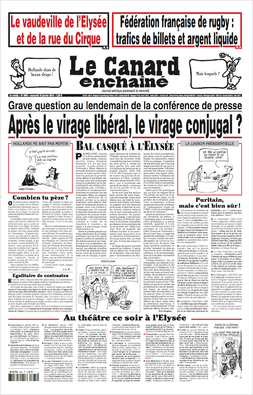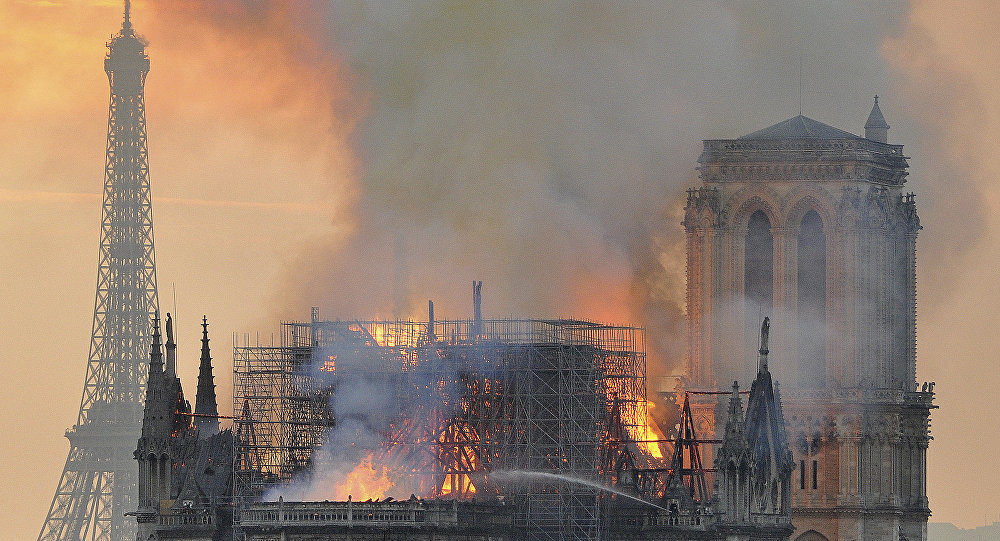Last development from Macron about the reconstruction of Notre-Dame:
Emmanuel Macron wants to use prescriptions to rebuild Notre-Dame in 5 years
Emmanuel Macron is definitely ready for anything for the reconstruction of Notre-Dame over five years. The question now is whether he is acting sincerely and setting a five-year deadline for such an important project or whether he is using Notre-Dame for political purposes with the sole aim of achieving his eventual re-election. In any case, in either case, he has absolutely nothing to lose.
On Tuesday, April 16, in a speech, the French President surprised many, promising the reconstruction of Notre-Dame within five days. " (...) I tell you this evening with strength: we are this people of builders. We have so much to rebuild. Then, yes, we will rebuild Notre-Dame Cathedral, even more beautiful. And I want it to be completed within five years," he said.
The day after this declaration, many specialists expressed reservations about the deadline set by the President of the Republic. For many architects, rebuilding Notre-Dame in five years is a chimera. Reconstruction is possible, but over several years.
Despite the reservations expressed by architects who were perfectly familiar with this subject, Macron insisted on wanting to rebuild everything in five years, even if it meant doing so by prescription. Indeed, on Wednesday, a bill for the five-year reconstruction of an eight-hundred year old cathedral was presented to the Council of Ministers.
In the press, we are informed that the text provides for authorizing the government to legislate by ordinances to ease the constraints of future reconstruction work. Thus, the works could not be subject to the public procurement code, there would also be less constraint on environmental standards, there could for example not be an environmental impact study of the works.
And that's not all. Notre-Dame could avoid the strict rules that govern work on historic monuments. According to Europe 1, there would be "more flexibility, with fewer procedures, authorisations and visits to committees". "This means that there would be no chief architect of historic monuments, usually the master on board in this kind of project," says Europe 1.
Well yes, if everything is ready... all that is missing is the official presidential boost so that the project is no longer one and can really see the light of day.
That's the conclusion of the French focus just published about this project:
L'incendie de Notre-Dame met en lumière un projet pré-existant de rénovation de l'Île de la Cité
"The Notre-Dame fire highlights a pre-existing project to renovate Île de la Cité"
Edit: I did not succeed to get the same result view of Sott Focus as
Chu did although I used the same code surrounding the URL link of the article...

French SOTT published a summary of the events, with much of what has been discusssed here:
Avec l'incendie de la cathédrale Notre-Dame de Paris, des questions se sont posées sur la possibilité que cet événement puisse survenir de manière accidentelle. De nouvelles informations sont depuis lors apparues. En voici un résumé. 1/ Le...

fr.sott.net
Most of what is inside was also shared here before, however, there is a bit more...
I did not really understand how Chu did to copy-paste "easily" (maybe not that easily... or by Pro access?) the whole previous French Focus about the fire...
So, I used another translation tool which directly translates from an URL: _lexilogos.com/traduction_page.htm
As I'm not so sure that it offers the most accurate translation or as "goog enough" than Deepl, I also have created a Word file of the French focus and translated it via Deepl with its "attached files option", and then attached both Pdf and Word of translated files. You also can follow the link above.
Here is the Lexilogos translation:
The fire of Notre-Dame has aroused and still raises many questions, and after taking stock
of this national drama in an article where we discussed the various ways that explain - or not - how this event could have happened so accidental, we will look today at a number of information available on the Net since the end of 2015 and try to understand who will take advantage of this fire to advance pawns that seem already ready to enter the game of chessboard .
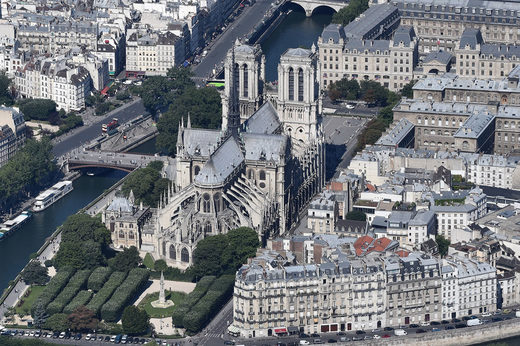
© AFP / Jean-Sebastien Evrard
Will this photo of the Ile de la Cité soon be a memory, a part of a past that should give way to a "modern" project?
Emmanuel Macron, the Olympics and the World Expo
The following may also answer the question of why
Emmanuel Macron Le Mal-Aimé , has kept repeating since the fire of Notre-Dame that "
we will rebuild all together " "by five years ":
"Come on the spot to see the extent of the damage, while the flames were not yet extinguished, Emmanuel Macron briefly spoke. " This cathedral we will rebuild all together, " said the President of the Republic, declaring to have "a thought" for both "Catholics", "Parisian and Paris", and all of his "compatriots" ". The head of state announced that a " national subscription " would be launched from Tuesday, April 16 to help rebuild the monument. "
And
to add the day after the fire of Notre-Dame that he wanted the latter to be rebuilt "even more beautiful" of "here five years".
But why in five years? We have heard here and there in the media that other historic buildings elsewhere in Europe in recent decades - or burned to be rebuilt in
five years -
Windsor Castle in England, or even less like the palace of
La Fenice in Venice in Italy (
in French The Phoenix ).
However, in five years we will be in 2024 and Paris will host the Olympic Games ... and should have hosted
the World Expo the following year , but Prime Minister Philippe Philippe withdrew the candidacy of France while President
Emmanuel Macron the ex-banker had agreed.
For Gilles Dufeigneux, former delegate general in charge of financing the French bid, Matignon's decision is "unjustified". Explanations according to
Le Figaro :
"A project that was competing for competition: the Olympic Games of 2024 in
Paris .Former general delegate of ExpoFrance 2025 responsible for the preparation of the application and its financing, Gilles Dufeigneux
considers that the arguments invoked by Édouard Philippe are "unjustified" and "incomprehensible" . And to recall that the President of the Republic, himself, had approved and signed the candidature file. "
Or about the
financing of the World Expo :
"The argument of the reluctance of private actors to engage is inappropriate for a project whose application is only financially supported by large corporate sponsors. This application, with a budget of 30 million euros, is entirely financed by private funds, without public subsidies . "
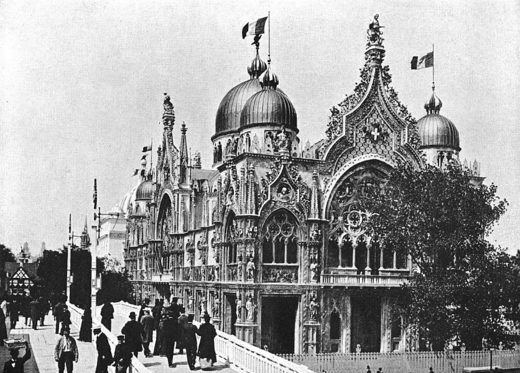
© Unknown
The Universal Exhibition of Paris in 1900
Later
in the same article , which predates the movement of yellow vests, the subject of the neglected territories in France - subject largely put forward since the beginning of the movement, by the yellow vests themselves and in particular by a whole group of mayors of the different French territories - is, as part of this exhibition, summarized as follows:
" The World Expo should not be held only in Paris, but also in the territories.
The application is particularly successful. It is original and innovative, qualities that our country needs so much in many ways. It is that of a whole country, not only of the capital city where all the decisions are made and unmade, but also of fifteen metropolises, departments, regions where thematic forums highlighting all the wealth and diversity of our territory had to stand. Give up in a few days a strategic airport infrastructure for the west of France and refuse, in these territories, who aspire to development, outreach and responsibility, the chance to participate in a great adventure of collective promotion of our country are at the beginning of the year very bad news.
[...]
It was in 1900 that France last organized the World Expo. The country was then much less developed in terms of infrastructure and had only 40 million inhabitants. That did not stop to welcome 42 million visitors, for the greater glory of our arts, our culture and our industries. "
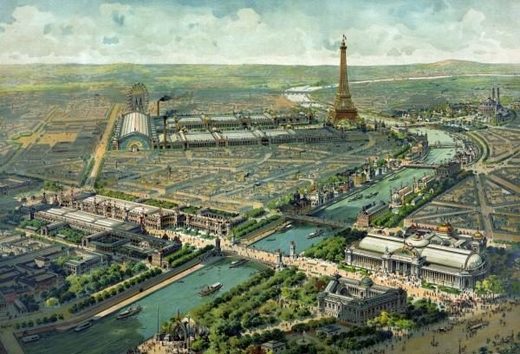
© Unknown
Aerial view of the Universal Exhibition of Paris in 1900
It seems that a Universal Exhibition on all French territories would have been much more rewarding and
hopeful for all .
We do not think (at all) that the Olympic Games will be or will be profitable or at least approximately balanced between their cost and their repayment by the financial revenues it generates and that do not go into the coffers of the State, but in those
of private companies participating in the Olympics and which is mostly exempt from taxes ). The previous Olympics elsewhere in the world have been rather catastrophic from a profitability point of view. So, must hope be removed from French hearts? Or should we even destroy what we have most sacred to impose
the new post-imperialist order erected to the glory of the worshipers of Mammon? A new world in which to ask legitimate questions
is now a crime ?
The mission of Dominique Perrault and Philippe Bélaval
To return to the heart of this article , it is by conducting research to try to explain - at least in part - how the fire of Notre-Dame could have occurred, that we - literally - came across information relating to projects of real estate restructuring of the entire Ile de la Cité on which stands (although a little less high today since it lost its arrow) Notre-Dame de Paris, an island whose perimeter is the most central of the spiral formed by the arrondissements of Paris, a perimeter which is classified as a Unesco Historic Monument.
It all started in December 2015 when
Dominique Perrault , a French architect whose work went beyond France to "shine" around the world, was entrusted by François Hollande with the mission of an "extraordinary" project. This French architect and urban planner to whom we owe the architecture of the National Library of France François Mitterand after winning the competition in 1989, sees his work exhibited in the largest museums in the world.
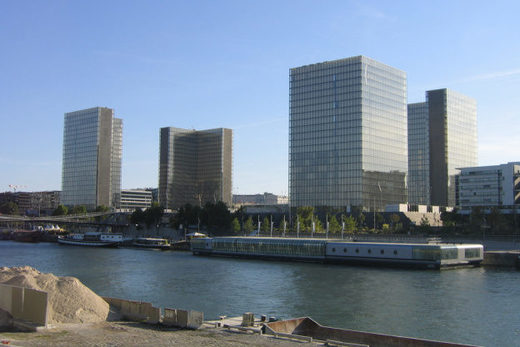
© Unknown
The National Library of France, site "François Mitterand"
Dominique Perrault's presidential mission was conducted in conjunction with Philippe Bélaval, president of the Center des monuments nationaux, and obtained the agreement of Anne Hidalgo, Mayor of Paris (as it should be). this mission had to "anticipate and guide" what could become of the Île de la Cité once it was
rid of the activities of these institutions that are the Prefecture of Police and the Court of Paris . What is done today:
For the Préfecture of police, this article of the
Parisian dated
September 20, 2017 , writes that
"the judicial police say goodbye to 36, quai des Orfèvres."
"The headquarters of the Paris Police Prefecture, on Ile de la Cité (IV) for a century, moved to the Batignolles, Porte de Clichy (17th), in the" Bastion ", the ultramodern building of the future court, overlooking the ring road
An empty building with two officials on duty like souls in pain, a page of history that turns, nostalgia and some festive farewell parties (see box) ... The 36, Quai des Orfèvres lives its last hours. This Wednesday, in this mythical building that was once a hive, punctuated by large criminal cases in the hands of the finest of the judicial police (PJ), he reigned a surprising calm. "
And for the Court of Paris, this article of the
World dated
April 16, 2018 , tells us that "
The first hearings were held Monday in the new court, which left the Ile de la Cité for the north-east of the capital city."
"After several centuries on the Ile de la Cité, the Paris court has left its historic setting where Marie Antoinette, Émile Zola and Philippe Pétain have been judged. While the move began in early March, the new courthouse, a large modern building in the Batignolles district, northwest of the capital, hosted its first hearing Monday, April 16. "
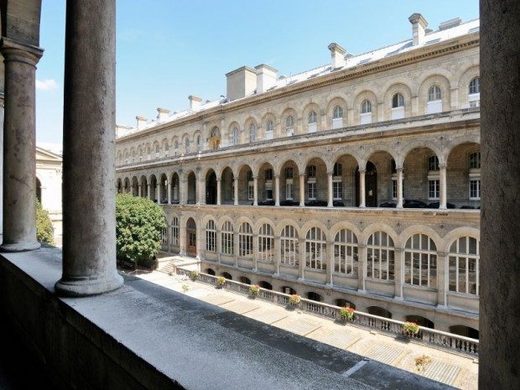
© François Marin
The hospital of the Hôtel-Dieu
It was also a question of "emptying" the hospital of the Hôtel-Dieu, but this one is the subject of renovations which will among other things transform it into a center of medical research, work which will end normally at the end of the 2020, which will cost a whopping EUR 100 million.
In a statement issued a few days ago , the AP-HP indicates that "the Hotel-Dieu is currently accelerating its transformation with a medical project and innovative research and enhanced cooperation with the hospital Cochin (Paris)." As of today, it proposes medical care, urgent or not, in a wide disciplinary field: emergencies, within a bi-site complementary to that of the hospital Cochin (14th), plateau consultations, with or without appointments, day hospitals, psychiatry, imaging (MRI and scanner) modern and efficient.
Source as of July 18, 2016
This presidential mission under the Dutch era was the subject of a report of 56 pages which was presented to the Head of State and the Mayor of Paris Anne Hidalgo, in the presence of Dominique Perrault (right of the Mayor of Paris) and
Philippe Bélaval (left of François Hollande) on December 16, 2016:
The
overall redevelopment project of Île de la Cité
Here is a video presentation of the project, video entitled "
Mission Island City, The heart of the heart - South Walk ":
There is no doubt that Emmanuel Macron took up the torch of his predecessor Hollande to complete this project within the five-year time frame for the opening of the Olympic Games.
The space freed by the relocation of certain institutions such as the Prefecture of Police and the Court of Paris has released about 100,000 m2 of space ... which,
according to the architect Perrault and Philippe Belaval , will represent "
a real estate value superior to EUR 1 billion without radical transformation [and] without the addition of new buildings or buildings in height. "
A bargain for real estate at the price of m2 in the 4th arrondissement of Paris: € 14,344 on average with a low range of € 12,923 and a high range of € 15,625.
There is no doubt that these prices will skyrocket(no pun intended)
when the "restructuring" of the Île de la Cité will be completed ...
As for the evaluation of the costs, the daily newspaper
Le Monde mentions the answers of Philippe Bélaval who would have declared according to
this Web site :
"For the moment, the two owners - Ile de la Cité - (the City of Paris and the State, about 50% each) are in favor. But none of them has the necessary financial resources for the project, "said Bélaval:" Hundreds of millions of euros, even billions , this has not been quantified ... "
That is also settled with the hundreds of millions of euros which are already acquired by the multiple donations in particular of some of the largest French companies (which should see at the end of the implementation of the project their investments largely paid), all those euros that fall from the sky as illustrated by the following picture:
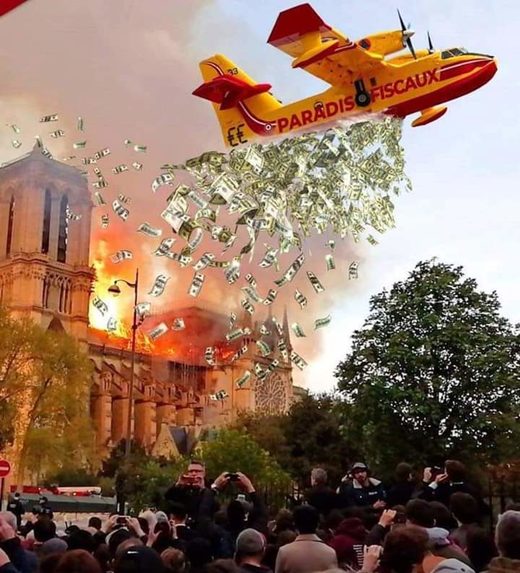
Donors are however not the preserve of the great French fortunes and the Notre-Dame Foundation linked to the diocese of Paris
announces on April 24th :
"32,000 donations from the general public, through our websites, online prize pools, checks (one-third of envelopes have already been opened), in France and the United States via the website of our American Friends Foundation of Notre-Dame de Paris, young but dynamic (7,000 American donations). These numbers move every day obviously, because the mobilization remains strong, even past this first week, including during the Easter weekend.
The wave of support has been truly global. This represents 4.6 million euros, including 0.6 from across the Atlantic.
All in all, important promises from individuals and companies generate a fundraising of at least 213 million euros . "
You can consult the exhaustive list of the list of private and public donors and updated regularly by Wikipedia.
Here are the "
main gifts ":
- Bettencourt & L'Oréal family: 200 million euros
- Arnault family & LVMH: 200 million euros
- Pinault & Artémis family: 100 million euros
- Total: 100 million euros
- JCDecaux: 20 million euros
- BNP Paribas: 20 million euros
- Axa France: 20 million euros
- Bouygues: 10 million euros
- Fimalac: 10 million euros
- Sanofi: 10 million euros
- Groupe BPCE: 10 million euros
- General company: 10 million euros
- Crédit Agricole Foundation: 5 million euros
- The Walt Disney Company: € 4.42 million
- French games: 2 million euros
- Capgemini: 1 million euros
- Michelin: 1 million euros
The total to date exceeds one billion euros and it is unlikely that the cost of the renovation of the Notre-Dame Cathedral in Paris alone requires such a sum,
which suggests that this is good money for the implementation of the project of global redevelopment of the Ile de la Cité, since as we saw above,
the State and the City of Paris who own 50% each do not have the financial means to carry out the development work presented by Dominique Perrault and Philippe Bélaval in 2016.
Here is more in detail
what we know about the "extraordinary" project presented by Dominique Perrault (also
on his architecture site ) and Philippe Bélaval:
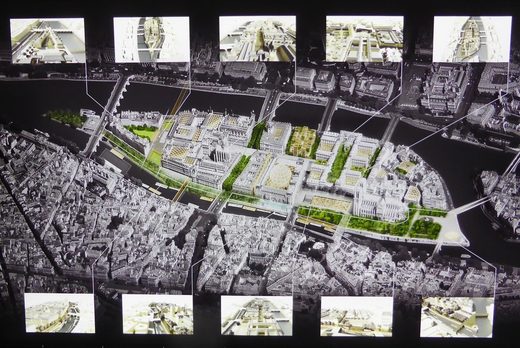
© perraultarchitecture.com
The redevelopment project of Ile de la Cité
Hereafter are the details for an even more "extraordinary" view:
- A monumental slab of transparent glass would cover the forecourt of Notre-Dame which would reflect and under which the archaeological crypt would become visible with a low place that would give direct access to the river:
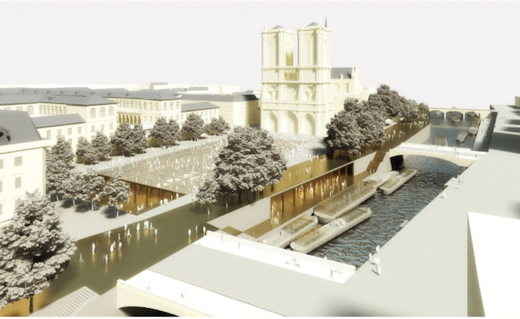
© perraultarchitecture.com
Glass forecourt on Notre Dame esplanade
- The reunification of the Sainte-Chapelle and the Conciergerie in a single visit;
- The transformation of the Rue de Lutèce into a large pedestrian promenade that would link the Law Courts to the Hôtel-Dieu. A place devised by the director of national monuments Philippe Bélaval,
"like St. Mark's Square in Venice ":
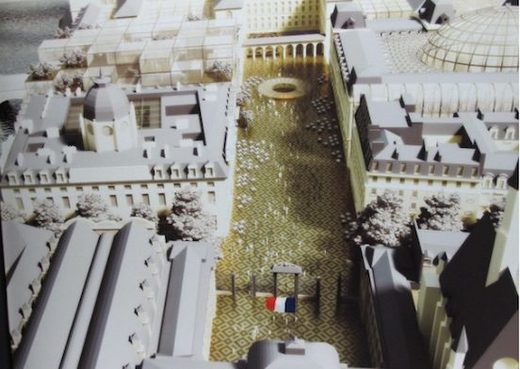
© perraultarchitecture.com
The "new Place of Lutece"
- Along the Seine, on the Quai Sud, a landing stage and floating platforms would host restaurants, cafes, a swimming pool (hopefully Olympic, sports facilities being so few in the heart of Paris), and concert halls:
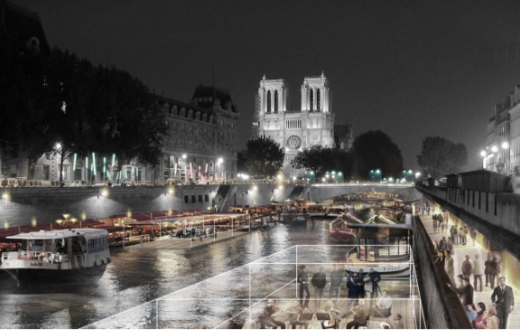
© perraultarchitecture.com
The new layout of the docks
- Along the Seine, a long vegetated walk (with or without cars, the subject already debating) would connect the two points East and West of the island:
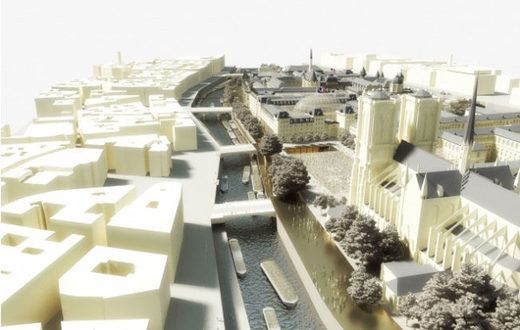
© perraultarchitecture.com
The long vegetated promenade on the left bank of Île de la Cité
- Two new bridges would cross the river:
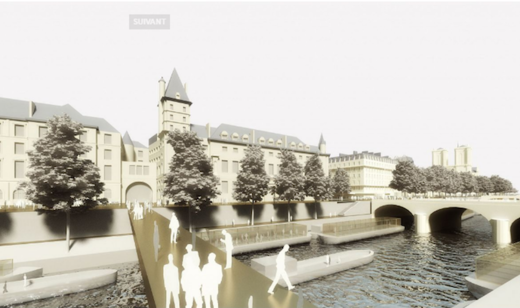
© perraultarchitecture.com
One of the two gateways
- Quantity of passages (including underground with natural light), atriums in the basement;
- Large covered courses.
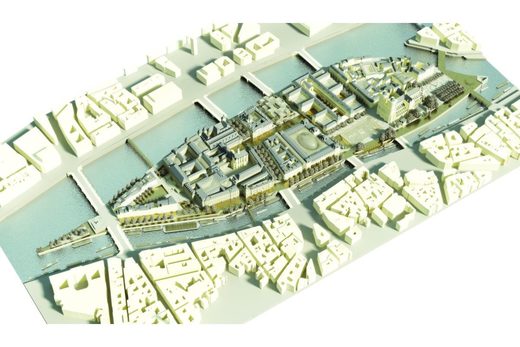
© perraultarchitecture.com
Global aerial view of the project
This project was the subject of an exhibition presenting the project in more detail, with maps, videos, models and educational panels of very large backlit format, at the
Conciergerie from February 15 to April 17, 2017.
We could also ask why only one architect was offered this mission ...
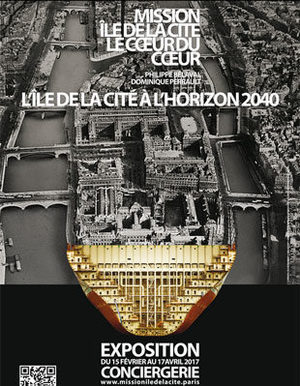
© The Conciergerie
Some experts have argued that five years would be too short a time for the restoration of the cathedral ... It may be relevant to think so, especially if one is not aware
at that time of a pre-project. established and the financial windfall that followed, two elements that could well justify the delay can be "shortened" to five years ...
To go further :
- The
4-page Pdf containing two visuals that are not included above;
- The
Pdf of the press release also containing several photos;
- The
56-page Pdf of the report entitled "Mission Island City - The Heart of the Heart" by Philippe Bélaval and Dominique Perrault in which we read that:
"The Ile de la Cité is the most conducive territory for the deployment of a great urban, cultural, architectural and economic ambition, which contributes to the influence of France."
At the end of the report, the list of interviews conducted for the preparation of the report shows names, which, if they seem logical at this stage, can leave a strange feeling ...
------------------
A last minute information (April 25, 2019)
informs us that Emmanuel Macron wishes to
"use the ordinances to rebuild Notre-Dame in 5 years" :
"In the press, we are informed that the text plans to allow the government to
legislate by order to ease the constraints of future reconstruction work.
Thus, the works might not be subject to the public procurement code , there would also be less constraint to environmental standards, it could for example not have an impact study work on the environment.
And that's not all. Notre Dame could be exempted from the strict rules governing work on historic monuments. According to
Europe 1 , there would be " more flexibility, with fewer procedures, authorizations and passages in committee ". "This means that there would be no chief architect of historical monuments, usually in this kind of project," says
Europe 1. "
Well, if everything is ready ... it only lacks
the official presidential boost so that the project is no longer one and he really sees the day.
We may have concrete answers shortly, and we will follow the case closely ...
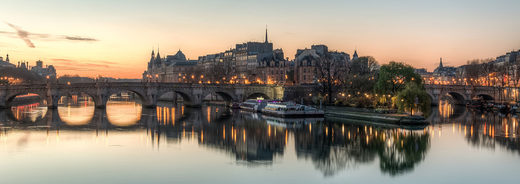
© Daniel Vorndran / DXR
Ile de la Cité, seen from Pont des Arts, shortly before sunrise, Paris, France.




